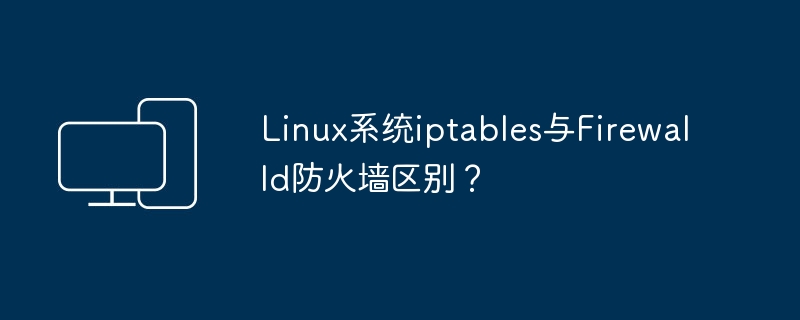
Everyone knows that in Kubernetes, kube-proxy is a network proxy. Its main responsibility is to provide load balancing and service discovery functions for services in the cluster. kube-proxy has different operating modes, among which iptables mode and ipvs mode are two common modes. In iptables mode, kube-proxy implements load balancing and service discovery through iptables rules, while ipvs mode uses the IPVS (IP Virtual Server) technology in the Linux kernel to achieve more efficient load balancing. Choosing the appropriate mode depends on your cluster's needs and performance requirements. The iptables mode is suitable for small clusters, while the ipvs mode is more suitable for large clusters because it provides better performance and scalability. Therefore, when deploying a Kubernetes cluster, it needs to be based on actual needs and regulations
iptables and ipvs are network proxy technologies in the Linux kernel, used for load balancing and service discovery. The difference between them is that iptables is a rule-based firewall, while ipvs is a network layer-based load balancing tool.
Different implementation methods
The implementation based on iptables rules is to add a set of rules on each node to achieve load balancing and service discovery; while ipvs is a kernel-level load balancing technology that can handle network proxies more efficiently. Iptables mainly focuses on filtering and forwarding network packets, while ipvs focuses on load balancing and traffic distribution, which can manage and optimize network resources more effectively. By reasonably combining the two, network traffic can be better balanced and efficiently processed, and the overall performance and stability of the system can be improved.
Different performance
Under high load conditions, kube-proxy in ipvs mode performs better because it performs network load balancing based on the kernel level and is more efficient. However, in some scenarios, Iptables mode may also achieve better performance.
Different functions
Kube-proxy in Iptables mode Before Kubernetes version 1.16, using iptables to implement port forwarding could only implement TCP-based load balancing and service discovery, and could not support four-layer load balancing. In Kubernetes version 1.16, the iptables-nat mode is added, which can support four-layer load balancing. In contrast, ipvs mode supports TCP, UDP, SCTP and four-layer load balancing, and supports multiple load balancing algorithms such as Online Hashed, IP Hash, Round Robin and Least Connection.
One disadvantage of iptables is that it operates at the kernel level. When iptables rules are too cumbersome, it may affect system performance. In addition, because iptables rules are centralized in the kernel, they are relatively difficult to modify.
In the Kubernetes system, the kubeadm management tool will select the ipvs mode by default to handle kube-proxy. At the same time, Kubernetes also provides a variety of exception handling mechanisms, such as automatic pull-up, rollback, failover, etc., to ensure the reliability of the system. , high availability and fault tolerance, thus avoiding possible problems that may arise during iptables processing and improving the performance of the entire system in terms of fault handling and fault tolerance.
The operation is on all nodes
Enable kernel support
<code>cat >> /etc/sysctl.conf/etc/sysconfig/modules/ipvs.modules</code>
The above is the detailed content of How to replace Iptables with Ipvs in a Kubernetes cluster. For more information, please follow other related articles on the PHP Chinese website!
 如何在 Alpine Linux 上启用或禁用防火墙?Feb 21, 2024 pm 12:45 PM
如何在 Alpine Linux 上启用或禁用防火墙?Feb 21, 2024 pm 12:45 PM在AlpineLinux上,你可以使用iptables工具来配置和管理防火墙规则。以下是在AlpineLinux上启用或禁用防火墙的基本步骤:检查防火墙状态:sudoiptables-L如果输出结果中显示有规则(例如,有一些INPUT、OUTPUT或FORWARD规则),则表示防火墙已启用。如果输出结果为空,则表示防火墙当前处于禁用状态。启用防火墙:sudoiptables-PINPUTACCEPTsudoiptables-POUTPUTACCEPTsudoiptables-PFORWARDAC
 如何在HAProxy中实现SSL通过Mar 20, 2024 am 09:30 AM
如何在HAProxy中实现SSL通过Mar 20, 2024 am 09:30 AM保持Web服务器负载平衡是预防停机的关键措施之一。使用负载平衡器是一种可靠的方法,其中HAProxy是一个备受推崇的选择。使用HAProxy,您可以精确配置负载平衡方式,同时支持SSL直通,从而保障客户端与服务器之间的通信安全。首先探讨在HAProxy中实现SSL直通的重要性,随后详细讨论了实施此功能所需的步骤,并提供了一个示例以便更好理解。什么是SSL通过?为什么它很重要?作为负载均衡器,HAProxy接受并分配流向您Web服务器的负载,在已配置的服务器上进行分发。负载的分配是针对客户端设备和
 什么是 nftables ? 它与 iptables 的区别是什么?Jun 09, 2023 pm 09:34 PM
什么是 nftables ? 它与 iptables 的区别是什么?Jun 09, 2023 pm 09:34 PM什么是nftables?它与iptables的区别是什么?几乎每个Linux管理员都使用过iptables,它是一个Linux系统的防火墙。但是你可能还不太熟悉nftables,这是一个新的防火墙,可为我们提供一些必需的升级,还有可能会取代iptables。为什么要使用nftables呢?nftables是由Netfilter开发的,该组织目前维护iptables。nftables的创建是为了解决iptables的一些性能和扩展问题。除了新的语法和一些升级以外,nftables的功能与iptab
 Debian下的iptables安装与配置指南Feb 15, 2024 am 08:30 AM
Debian下的iptables安装与配置指南Feb 15, 2024 am 08:30 AM在Linux系统中,iptables是用于配置和管理网络数据包过滤规则的工具,它允许用户根据预设的规则对进入和离开网络的数据包进行过滤,从而实现网络访问控制、数据包转发等网络功能,在Debian系统中,iptables是默认安装的,但如果没有安装,则需要手动安装,本文将介绍如何在Debian下安装iptables,并配置相关的规则。安装iptables1.打开终端,以root用户身份登录。2.运行以下命令安装iptables:```shellsudoapt-getupdatesudoapt-ge
 如何处理Linux系统中频繁出现的服务器负载过高问题Jun 29, 2023 pm 11:56 PM
如何处理Linux系统中频繁出现的服务器负载过高问题Jun 29, 2023 pm 11:56 PM如何处理Linux系统中频繁出现的服务器负载过高问题摘要:本文介绍了如何处理Linux系统中频繁出现的服务器负载过高问题。通过优化系统配置、调整服务资源分配、检测问题进程和运行性能调优等方法,可以有效降低负载并提高服务器的性能和稳定性。一、引言服务器负载过高是Linux系统中常见的问题之一,会导致服务器运行缓慢、响应不及时,甚至无法正常工作。面对这个问题,我
 Linux系统iptables与Firewalld防火墙区别?Feb 19, 2024 pm 05:18 PM
Linux系统iptables与Firewalld防火墙区别?Feb 19, 2024 pm 05:18 PMLinux系统中的iptables和Firewalld都是用于配置防火墙规则的工具,它们在功能和使用方式上有一些区别:iptables:iptables是Linux系统中最经典和传统的防火墙工具,早期版本的Linux默认使用iptables作为防火墙配置工具。iptables基于内核空间的netfilter框架,通过直接操作内核中的iptables规则表来过滤和处理网络数据包。iptables使用规则链(rulechains)和表(tables)的概念来组织和管理防火墙规则,例如常见的filte
 Linux应该怎么理解“平均负载”?Feb 28, 2024 pm 06:43 PM
Linux应该怎么理解“平均负载”?Feb 28, 2024 pm 06:43 PM通常在发现系统变慢时,我们会首先通过执行top或者uptime命令来查看系统的负载情况。比如,我输入了uptime命令后,系统立即显示了相关结果。$uptime02:34:03up2days,20:14,1user,loadaverage:0.63,0.83,0.88前面的几列我们都比较熟悉,它们分别是当前时间、系统运行时间以及正在登录用户数102:34:03//当前时间2up2days,20:14//系统运行时间31user//正在登录用户数而最后三个数字呢,依次则是过去1分钟、5分钟、15分
 不会用 Linux 防火墙软件 IPtables!你算啥运维人!Aug 01, 2023 pm 05:36 PM
不会用 Linux 防火墙软件 IPtables!你算啥运维人!Aug 01, 2023 pm 05:36 PM连接跟踪是许多网络应用的基础。例如,Kubernetes Service、ServiceMesh sidecar、 软件四层负载均衡器 LVS/IPVS、Docker network、OVS、iptables 主机防火墙等等,都依赖连接跟踪功能。


Hot AI Tools

Undresser.AI Undress
AI-powered app for creating realistic nude photos

AI Clothes Remover
Online AI tool for removing clothes from photos.

Undress AI Tool
Undress images for free

Clothoff.io
AI clothes remover

AI Hentai Generator
Generate AI Hentai for free.

Hot Article

Hot Tools

SAP NetWeaver Server Adapter for Eclipse
Integrate Eclipse with SAP NetWeaver application server.

Dreamweaver Mac version
Visual web development tools

SecLists
SecLists is the ultimate security tester's companion. It is a collection of various types of lists that are frequently used during security assessments, all in one place. SecLists helps make security testing more efficient and productive by conveniently providing all the lists a security tester might need. List types include usernames, passwords, URLs, fuzzing payloads, sensitive data patterns, web shells, and more. The tester can simply pull this repository onto a new test machine and he will have access to every type of list he needs.

SublimeText3 Linux new version
SublimeText3 Linux latest version

EditPlus Chinese cracked version
Small size, syntax highlighting, does not support code prompt function





